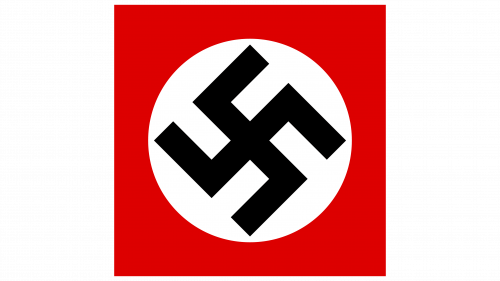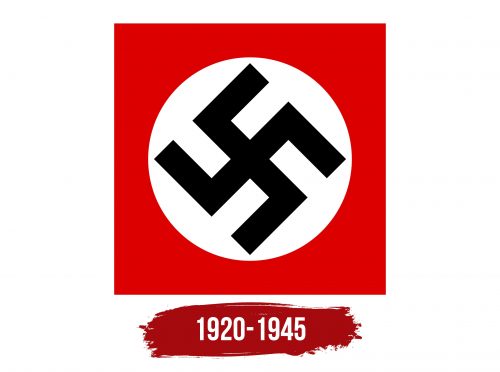The Nazi logo has ancient origins, as it contains a swastika—a mysterious symbol that is several thousand years old. German fascists appropriated this globally recognized symbol and completely distorted its meaning, so now it is associated with the crimes of the Nazi regime.
Nazi: Brand overview
When Adolf Hitler came to power in 1933, Germany entered a dark period marked by dictatorship, war, and numerous atrocities. This era, often referred to as Nazi Germany, was a pivotal time in world history, lasting until 1945. The Nazi regime brought political, social, and economic changes that left lasting effects on Europe and the world.
The foundations of Nazi Germany were laid after World War I. Following its defeat, Germany was devastated by the harsh terms of the Treaty of Versailles. The country experienced hyperinflation and widespread unemployment, crippling its economy. These conditions made the Weimar Republic unpopular among many Germans, who saw it as weak. It was in this climate of unrest that Adolf Hitler and the National Socialist German Workers’ Party (NSDAP), known as the Nazi Party, rose to prominence.
Hitler, a powerful orator, used his speeches to stir nationalist sentiments and promised to restore Germany’s lost honor. He fueled fears about supposed threats from Jews and Communists while also addressing economic concerns. By 1933, the Nazi Party had become one of the most powerful political forces in Germany, and Hitler was appointed Chancellor. Soon after, he moved quickly to consolidate his power.
In the early years of his rule, Hitler used violence and political manipulation to eliminate his opponents. The 1933 Reichstag Fire provided him with an excuse to pass the Reichstag Fire Decree, which suspended civil liberties and allowed the arrest of Communists and others who opposed his agenda. With the passage of the Enabling Act, Hitler gained the power to rule by decree, effectively dismantling Germany’s democratic institutions. Within months, Germany had become a one-party state under Nazi control.
Once in power, the Nazi regime imposed a harsh rule that affected nearly every aspect of society. Propaganda played a major role in shaping public opinion and promoting Nazi ideology. Joseph Goebbels, head of the Ministry of Public Enlightenment and Propaganda, controlled the media, arts, and information, portraying Hitler as the savior of the German people.
Education was another tool for shaping public thought, especially among the youth. Schools taught racial theories, emphasizing the supposed superiority of the “Aryan race.” Organizations like the League of German Girls and Hitler Youth were established to indoctrinate the younger generation into supporting the regime.
The Nazi government also enacted laws that discriminated against Jews and other minorities. One of the most significant of these was the 1935 Nuremberg Laws, which stripped Jews of their citizenship and prohibited marriages between Jews and non-Jews. The regime’s racist ideology promoted the idea of racial purity, classifying people based on their ethnic backgrounds.
In addition to promoting racial laws, the Nazi regime created a police state. The Gestapo, Nazi Germany’s secret police, was tasked with crushing opposition. Many people were arrested or disappeared into concentration camps, while others lived in constant fear of being reported for anti-Nazi activities. Under Heinrich Himmler, the SS played a key role in executing Nazi policies and ultimately oversaw the Holocaust.
Hitler’s ambitions extended beyond Germany’s borders. He aimed to establish the Third Reich, an empire dominating Europe. The idea of “Lebensraum,” or living space, was central to this vision, advocating for the expansion of Germany’s territory, particularly to the east, into lands inhabited by people the Nazis deemed racially inferior.
Nazi Germany began its expansion in 1938 with the annexation of Austria, known as the “Anschluss.” Shortly after, the Munich Agreement allowed Germany to annex the Sudetenland, part of Czechoslovakia, without facing military opposition from France or Britain in an attempt to avoid conflict.
In September 1939, Germany’s invasion of Poland triggered World War II. Using air strikes and fast-moving ground forces in a strategy known as Blitzkrieg, or “lightning war,” Germany swiftly conquered Poland. The war quickly escalated, drawing in the Soviet Union, the United States, and France. Germany’s military enjoyed early success, taking control of much of Europe, including France, and posing a serious threat to Britain.
As the war progressed, Nazi Germany’s brutality intensified, especially towards Jews and other persecuted groups. Hitler’s regime initiated the Holocaust, the systematic murder of six million Jews, as well as millions of others, including disabled individuals, political dissidents, and Romani people.
The Holocaust was carried out through a network of concentration and extermination camps, where victims were subjected to mass murder, starvation, and forced labor. Auschwitz, the largest of these camps, became a symbol of the horrors of the Holocaust. This genocide, now considered one of the darkest chapters in human history, was the culmination of the Nazi regime’s racial policies.
By 1943, the tide of war had turned against Nazi Germany. A key turning point was the failure of the German invasion of the Soviet Union, particularly the defeat at Stalingrad. In 1944, Allied forces, including the United States and the United Kingdom, opened new fronts in North Africa, Italy, and eventually France, as Germany’s forces were pushed back on all sides.
By 1945, Nazi Germany was on the brink of collapse. Soviet troops approached from the east, while Allied forces advanced from the west. Hitler, refusing to surrender, remained in his Berlin bunker and committed suicide on April 30, 1945. Just days later, on May 7, 1945, Germany formally surrendered to the Allies, marking the end of the war in Europe and the fall of the Nazi regime.
The legacy of Nazi Germany is one of destruction and immense human suffering. Adolf Hitler’s dictatorship devastated Europe and caused the deaths of millions. The fall of Nazi Germany in 1945 ended one of the most brutal regimes in modern history. The lessons of this period serve as a lasting reminder of the dangers of tyranny, hatred, and unchecked power.
Meaning and History
What is Nazi?
This is the National Socialist German Workers’ Party, or “Nazis,” which Adolf Hitler brought to power in Germany in 1933, becoming the embodiment of a far-right political movement. They were characterized by anti-Semitism, belief in racial superiority, and nationalism. The party’s primary goal was to create a “pure” Aryan nation, excluding other ethnic groups and exterminating Jews and other opponents through the Holocaust. The Nazis actively used propaganda and suppressed any resistance, maintaining totalitarian control through harsh social and political measures, leading to the deaths of millions of people and the devastation of Europe during World War II.
1920 – 1945
The swastika, known in Asian countries as a symbol of good luck and spiritual development, entered the Western world in the early 20th century with the National Socialist German Workers’ Party. This ancient religious and cultural symbol took on a negative meaning, associated with the ideology of fascism, racism, anti-Semitism, and aggression during World War II.
The Nazis became interested in the swastika after archaeologists discovered similar patterns on artifacts of Indo-European cultures. Proponents of the “Aryan supremacy” theory decided that the hooked cross perfectly conveyed the greatness of the “chosen” peoples and deserved to become the center of their visual identity.
However, it is mistaken to believe that the swastika historically belonged exclusively to the fictional “Aryan” race. Similar symbols have appeared on different continents; each found artifact is already several thousand years old. It is assumed that all these signs may have common origins: according to one version, ancient people depicted a rotating meteorite, visible in the sky worldwide, whose impact caused a catastrophe on Earth.
Regardless, German fascists manipulated public consciousness and used the ancient symbol to create the false impression that their ideology’s principles date back to prehistoric times. The Nazi logo contains the right-facing version of the swastika—the one that rotates clockwise.
The black hooked cross is positioned at an angle, resembling a diamond. It is inscribed in a white circle, set against a red rectangle’s background. This color combination reflects the nationalist aspirations of the party:
- Red represents the ideas of socialism (as understood by the Nazis);
- White denotes the purity of the so-called “Aryan race”;
- Black is associated with the concept of strength and order, which the fascists sought to impose on society.
The colors used were familiar to the German public, thanks to the flag of the German Reich from World War I. This helped the party attract patriots who were nostalgic for the vanished empire. The black swastika against the white and red elements symbolized the struggle for “Aryan supremacy.”
Thus, an ancient, respected symbol with a history spanning over a thousand years became the official sign of the Nazis. It is banned in many countries due to its association with the crimes of the fascist regime, genocide, and the Holocaust.





